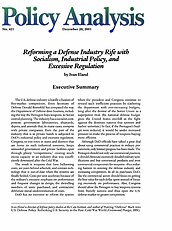The result is weapons that have ballooning costs, are years behind schedule, and contain technology that is out-of-date when the systems are finally fielded. Costs per unit accelerate because of the military’s excessive emphasis on performance and frequent changes in design, the dwindling numbers of units purchased, and contractors’ deliberate initial underestimation of costs.
DoD has no incentive to reform the system when the president and Congress continue to reward such inefficient practices by slathering the department with ever-increasing budgets, long after the demise of the Soviet Union as a superpower rival. (Its national defense budget gives the United States overkill in the fight against the destitute nations that sponsor and harbor terrorists.) In fact, if the Pentagon’s budget were reduced, it would be under increased pressure to make the process of weapons buying more efficient.
Although DoD officials have talked a great deal about using commercial practices in military procurement, only limited progress has been made. The Pentagon should not only use commercial practices; it should eliminate excessively detailed military specifications and buy commercial products and even commercial components for weaponsthus reducing barriers to entering the defense industry and increasing competition. In all its purchases, DoD, like the commercial sector, should focus on getting the best value for each dollar spent instead of focusing excessively on performance. Also, Congress should allow the Pentagon to buy weapons systems from friendly nations and thus open the U.S. defense market to greater competition.


